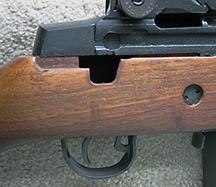Designer Elmer C. Ballance | Designed 1974 | |
 | ||
Manufacturer Springfield Armory, Inc. Unit cost $2,000 (Standard model) | ||
The Springfield Armory M1A is a civilian version of the M14 rifle designed and manufactured by Springfield Armory, Inc. in 1974. The term "M1A" is a proprietary title for Springfield Armory's M14-pattern rifle. Early M1A rifles were built with surplus G.I. parts until Springfield Armory, Inc. began manufacturing their own.
Contents
Differences between the M1A and M14
The M14 was developed to take the place of four different weapons systems—the M1 rifle, the M1 Carbine, the M3 "Grease Gun" and the M1918 Browning Automatic Rifle (BAR). It was thought that in this manner the M14 could simplify the logistical requirements of the troops by limiting the types of ammunition and parts needed to be supplied. It proved to be an impossible task to replace all four as the cartridge was too powerful for the submachine gun role and the weapon was too light to serve as a light machine gun replacement for the BAR. (The M60 machine gun better served this specific task.)
The Springfield Armory M1A is, for the most part, identical to the M14. There are, however, a few important differences:
Early M1A receivers were made from surplus M14 receiver blanks, current M1A receivers are made from precision investment cast AISI 8620 alloy steel. The military M14 receivers were manufactured using the drop forge process, which is more complicated and more expensive. Until around the late 1990s, the M1A produced by Springfield Armory retained the cutout in the rear right of the stock for the selector switch found on the M14. Springfield Armory has also omitted the "7.62-MM" caliber designator on the M1A receiver since 1991.
Once the Federal Assault Weapons Ban of 1994 was passed, prohibiting the manufacture of firearms with bayonet lugs (among other features), the M1A no longer shipped with a bayonet lug. Although the 1994 law expired in September 2004, making bayonet lugs on newly manufactured firearms legal again (in most states), Springfield Armory has not restored that feature. Since the bayonet lug is attached to the flash suppressor, "post ban" rifles can easily be fitted with a bayonet lug by fitting a pre-ban flash suppressor.
The California Assault Weapons Ban, which went into effect January 1, 2000, prohibited flash suppressors on all semi-automatic rifles capable of accepting a detachable magazine. As a result, Springfield Armory designed a muzzle brake, which they installed in place of the standard flash suppressor on all models that were sold in California. The muzzle brake reduces climb of the barrel, allowing the operator to aim more quickly for another shot.
M1A/M14 select fire rifles
Most of the M1A rifles manufactured since 1971 were made for the commercial market and thus were only capable of semi-automatic fire. Springfield Armory, Inc. and Smith Enterprise Inc. were the two companies that produced select fire M14 type rifles for civilian ownership. Up until May 1986, Springfield Armory, Inc. had a Full Auto Department at their factory in Illinois. A few M1A rifles were converted to full-auto fire and registered with the ATF by Class II manufacturers like Neal Smith and Rock Island Armory. The receivers of these select fire rifles have the selector lug and operating rod rail cuts for the connector assembly.
Variants
Besides the standard M1A, Springfield Armory also produces multiple variants including the M21 Tactical and M25 White Feather.
Loaded rifles
The Loaded variants are available with either a walnut or synthetic stock, and one model comes with an Extended Cluster Rail Fiberglass Stock. All Loaded models include the following features:
The Loaded models do not have the action glass bedded into the stock as do the National Match models. While the National Match features included lend considerably to the Loaded models' accuracy, they are not a true National Match rifle.
Source
Match rifles
Two M1As are advertised as match rifles, the National Match M1A and the Super Match M1A. The National Match is a more basic model, while the Super Match is more customizable has additional features on some models such as a McMillan stock and a Douglas stainless steel barrel.
Scout Squad
The Scout Squad is an M1A marketed toward law enforcement users. It has an 18-inch barrel, a forward mounted optical sight base, and a proprietary muzzle stabilizer. It is advertised as being optimal for Aimpoint optics, however, most mounts attached to the factory rail will still require a cheekrest in order to get the proper weld. It is available in both wood stocked and synthetic furniture options with different colours of wood and synthetic stocks.
SOCOM rifles
The SOCOM II and SOCOM 16 are modern variants of the M14 manufactured with lighter materials. This rifle is the shortest barrel length (16 inches) for a rifle permissible without taxing and registration under the National Firearms Act in the United States. The gas system was reworked to ensure proper operation with the shortened barrel, and a new compensator was added to help soften recoil. The SOCOM II features a "Cluster Rail System", while the SOCOM 16 has a single short scope base. Another, more rare variant called the SOCOM II Extended Cluster Rail features a longer top rail that extends over the ejection port to the stripper clip guide, allowing the operator to mount optics farther to the rear.
